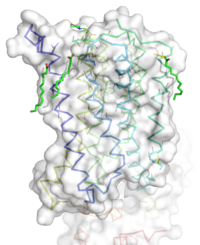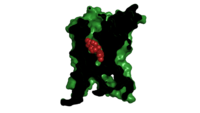Sandbox Reserved 1160
From Proteopedia
(Difference between revisions)
| Line 1: | Line 1: | ||
== Human metabotropic glutamate receptor 5 transmembrane domain == | == Human metabotropic glutamate receptor 5 transmembrane domain == | ||
<StructureSection load='4oo9' size='300' frame='true' side='right' caption='Human metabotropic glutamate receptor 5 transmembrane domain' scene='72/721531/Protien_clean_sce/1'> | <StructureSection load='4oo9' size='300' frame='true' side='right' caption='Human metabotropic glutamate receptor 5 transmembrane domain' scene='72/721531/Protien_clean_sce/1'> | ||
| - | Receiving and responding to extracellular messages is critical to the proper function of the nervous system. Glutamate is the major excitory neurotransmitter of the CNS, and metabotropic glutamate receptor 5 will play a major role in glutamate signaling. Metabotropic glutamate receptor 5 transmembrane domain is a homodimeric [[GPCR]] that resides in the cellular membrane <ref name="Dore" />. This domain is a member of the Class C GPCR family and can further be categorized into the Group I subgroup<ref name="Wu" />. The transmembrane domain will signal through a Gq/11 pathway<ref name="Dore" />. mGlu5 will bind glutamate to the extracellular Venus flytrap domain and the signal will be transduced across the membrane to a heterotrimeric G protein, which will ultimately lead to calcium release and activation of PKC<ref name="Wu" />. This will elicit a excitory post-synaptic repose and modulate long term potentiation<ref name="Wu" />. Human metabotropic glutamate receptor 5 is found throughout the central nervous system. Areas containing high concentrations of this protein are often involved in emotional processing and higher cognition<ref name="Niswender" />. The localization of mGlu5 in the CNS and the presence of multiple domains makes mGlu5 a possible target for treating schizophrenia,[http://www.fragilex.org/fragile-x/fragile-x-syndrome/ Fragile X], depression, anxiety, and Alzheimer's disease<ref name="Wu" />. | + | Receiving and responding to extracellular messages is critical to the proper function of the nervous system. Glutamate is the major excitory neurotransmitter of the CNS, and metabotropic glutamate receptor 5 will play a major role in glutamate signaling. Metabotropic glutamate receptor 5 transmembrane domain is a homodimeric [[GPCR]] that resides in the cellular membrane <ref name="Dore" />. This domain is a member of the Class C GPCR family and can further be categorized into the Group I subgroup<ref name="Wu" />. The transmembrane domain will signal through a Gq/11 pathway<ref name="Dore" />. mGlu5 will bind glutamate to the extracellular Venus flytrap domain and the signal will be transduced across the membrane to a heterotrimeric G protein, which will ultimately lead to calcium release and activation of [[PKC]]<ref name="Wu" />. This will elicit a excitory post-synaptic repose and modulate long term potentiation<ref name="Wu" />. Human metabotropic glutamate receptor 5 is found throughout the central nervous system. Areas containing high concentrations of this protein are often involved in emotional processing and higher cognition<ref name="Niswender" />. The localization of mGlu5 in the CNS and the presence of multiple domains makes mGlu5 a possible target for treating schizophrenia,[http://www.fragilex.org/fragile-x/fragile-x-syndrome/ Fragile X], depression, anxiety, and Alzheimer's disease<ref name="Wu" />. |
== Discovery == | == Discovery == | ||
| Line 24: | Line 24: | ||
=== Ionic Locks === | === Ionic Locks === | ||
| - | Another important structural feature of the protein is the series of <scene name='72/721531/Ionic_lock/2'>ionic locks</scene> on the intracellular side of the protein. Interaction between amino acids will form a salt bridge which will stabilize the inactive conformation<ref name="Dore" />. The primary ionic lock forms between Glu770, Lys665, and Ser613<ref name="Dore" />. A secondary ionic lock occurs between Ser614 and Arg668<ref name="Dore" />. The purpose of these ionic locks is analogous to the ionic interactions that stabilize the T state in [[Hemoglobin]]. In the case of the TMD, when the NAM mavoglurant is bound the ionic lock is formed. This stabilizes the inactive state, where the intracellular loops are stabilized inwards<ref name="Wu" />. This will effectively block the crevice that is involved in binding the G-protein<ref name="Wu" />. Models have suggested that, even in a glutamate bound state, the mavoglurant bound receptor would be dimerized but incapable of signaling<ref name="Wu" />. This helps maintain the readiness of the pathway, while still decreasing signal response. | + | Another important structural feature of the protein is the series of <scene name='72/721531/Ionic_lock/2'>ionic locks</scene> on the intracellular side of the protein. Interaction between amino acids will form a salt bridge, which will stabilize the inactive conformation<ref name="Dore" />. The primary ionic lock forms between Glu770, Lys665, and Ser613<ref name="Dore" />. A secondary ionic lock occurs between Ser614 and Arg668<ref name="Dore" />. The purpose of these ionic locks is analogous to the ionic interactions that stabilize the T state in [[Hemoglobin]]. In the case of the TMD, when the NAM mavoglurant is bound the ionic lock is formed. This stabilizes the inactive state, where the intracellular loops are stabilized inwards<ref name="Wu" />. This will effectively block the crevice that is involved in binding the G-protein<ref name="Wu" />. Models have suggested that, even in a glutamate bound state, the mavoglurant bound receptor would be dimerized but incapable of signaling<ref name="Wu" />. This helps maintain the readiness of the pathway, while still decreasing signal response. |
== Function and Pathway == | == Function and Pathway == | ||
| - | It all begins with glutamate binding to the venus fly trap domain. The signal transduction goes across the cystine-rich domain to the TMD. Next the dimerization of the TMD occurs. This activates the Gq/11 pathway, which activates phspholipase Cβ<ref name="Niswender" />. The active phospholipase Cβ performs hydrolysis on phosphotinositides and generates inositol 1,4,5-trisphosphate and diacyl-glycerol<ref name="Woodcock" />. This results in calcium mobilization and activation of | + | It all begins with glutamate binding to the venus fly trap domain. The signal transduction goes across the cystine-rich domain to the TMD. Next the dimerization of the TMD occurs. This activates the Gq/11 pathway, which activates phspholipase Cβ<ref name="Niswender" />. The active phospholipase Cβ performs hydrolysis on phosphotinositides and generates inositol 1,4,5-trisphosphate and diacyl-glycerol<ref name="Woodcock" />. This results in calcium mobilization and activation of PKC<ref name="Niswender" />. |
== Disease == | == Disease == | ||
| Line 44: | Line 44: | ||
== External Resources == | == External Resources == | ||
[http://www.fraxa.org/novartis-discontinues-development-mavoglurant-afq056-fragile-x-syndrome/ Novartis Fragile X trials] | [http://www.fraxa.org/novartis-discontinues-development-mavoglurant-afq056-fragile-x-syndrome/ Novartis Fragile X trials] | ||
| + | [http://www.en.wikipedia.org/wiki/Gq_alpha_subunit] | ||
Revision as of 11:26, 30 March 2016
Human metabotropic glutamate receptor 5 transmembrane domain
| |||||||||||


